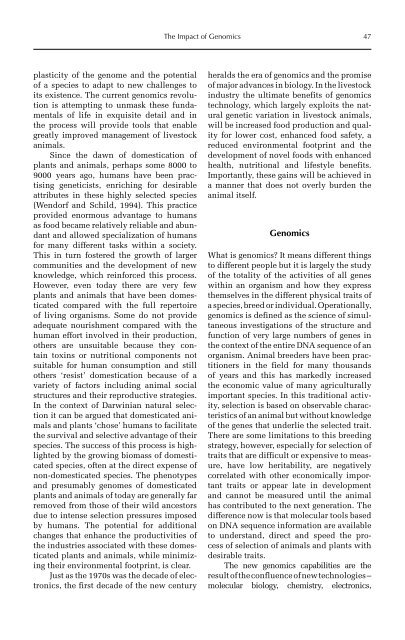Redesigning Animal Agriculture
Redesigning Animal Agriculture
Redesigning Animal Agriculture
Create successful ePaper yourself
Turn your PDF publications into a flip-book with our unique Google optimized e-Paper software.
plasticity of the genome and the potential<br />
of a species to adapt to new challenges to<br />
its existence. The current genomics revolution<br />
is attempting to unmask these fundamentals<br />
of life in exquisite detail and in<br />
the process will provide tools that enable<br />
greatly improved management of livestock<br />
animals.<br />
Since the dawn of domestication of<br />
plants and animals, perhaps some 8000 to<br />
9000 years ago, humans have been practising<br />
geneticists, enriching for desirable<br />
attributes in these highly selected species<br />
(Wendorf and Schild, 1994). This practice<br />
provided enormous advantage to humans<br />
as food became relatively reliable and abundant<br />
and allowed specialization of humans<br />
for many different tasks within a society.<br />
This in turn fostered the growth of larger<br />
communities and the development of new<br />
knowledge, which reinforced this process.<br />
However, even today there are very few<br />
plants and animals that have been domesticated<br />
compared with the full repertoire<br />
of living organisms. Some do not provide<br />
adequate nourishment compared with the<br />
human effort involved in their production,<br />
others are unsuitable because they contain<br />
toxins or nutritional components not<br />
suitable for human consumption and still<br />
others ‘resist’ domestication because of a<br />
variety of factors including animal social<br />
structures and their reproductive strategies.<br />
In the context of Darwinian natural selection<br />
it can be argued that domesticated animals<br />
and plants ‘chose’ humans to facilitate<br />
the survival and selective advantage of their<br />
species. The success of this process is highlighted<br />
by the growing biomass of domesticated<br />
species, often at the direct expense of<br />
non-domesticated species. The phenotypes<br />
and presumably genomes of domesticated<br />
plants and animals of today are generally far<br />
removed from those of their wild ancestors<br />
due to intense selection pressures imposed<br />
by humans. The potential for additional<br />
changes that enhance the productivities of<br />
the industries associated with these domesticated<br />
plants and animals, while minimizing<br />
their environmental footprint, is clear.<br />
Just as the 1970s was the decade of electronics,<br />
the first decade of the new century<br />
The Impact of Genomics 47<br />
heralds the era of genomics and the promise<br />
of major advances in biology. In the livestock<br />
industry the ultimate benefits of genomics<br />
technology, which largely exploits the natural<br />
genetic variation in livestock animals,<br />
will be increased food production and quality<br />
for lower cost, enhanced food safety, a<br />
reduced environmental footprint and the<br />
development of novel foods with enhanced<br />
health, nutritional and lifestyle benefits.<br />
Importantly, these gains will be achieved in<br />
a manner that does not overly burden the<br />
animal itself.<br />
Genomics<br />
What is genomics? It means different things<br />
to different people but it is largely the study<br />
of the totality of the activities of all genes<br />
within an organism and how they express<br />
themselves in the different physical traits of<br />
a species, breed or individual. Operationally,<br />
genomics is defined as the science of simultaneous<br />
investigations of the structure and<br />
function of very large numbers of genes in<br />
the context of the entire DNA sequence of an<br />
organism. <strong>Animal</strong> breeders have been practitioners<br />
in the field for many thousands<br />
of years and this has markedly increased<br />
the economic value of many agriculturally<br />
important species. In this traditional activity,<br />
selection is based on observable characteristics<br />
of an animal but without knowledge<br />
of the genes that underlie the selected trait.<br />
There are some limitations to this breeding<br />
strategy, however, especially for selection of<br />
traits that are difficult or expensive to measure,<br />
have low heritability, are negatively<br />
correlated with other economically important<br />
traits or appear late in development<br />
and cannot be measured until the animal<br />
has contributed to the next generation. The<br />
difference now is that molecular tools based<br />
on DNA sequence information are available<br />
to understand, direct and speed the process<br />
of selection of animals and plants with<br />
desirable traits.<br />
The new genomics capabilities are the<br />
result of the confluence of new technologies –<br />
molecular biology, chemistry, electronics,










